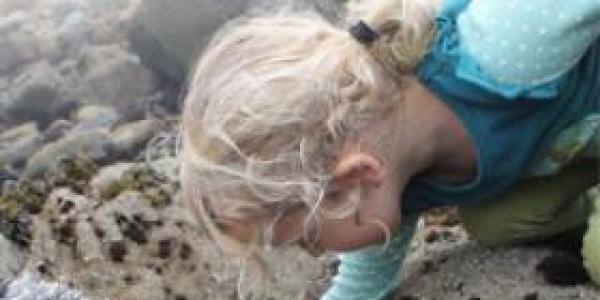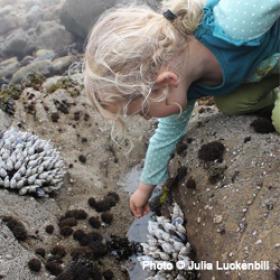STEM (Science, Technology, Engineering, and Mathematics) at the Sea

You are here
Home / Our Work / For Families / Articles for Families on Science, Nutrition, and Safety / STEM (Science, Technology, Engineering, and Mathematics) at the Sea
By: Julia Luckenbill

Summertime…and children are at play at the ocean, sifting through sand, scooping up buckets of water, and chasing the waves. You’d be surprised at how much science and math children are learning as they play!
- Volume—Infants, toddlers and preschoolers enjoy filling and emptying buckets. They explore how many things their hands, pockets, and shirts can hold. Some children may enjoy filling shells with smaller shells or rocks.
- Physics, architecture, and engineering—It’s fun to stack rocks in tippy piles. When will they fall? Balancing on rocks keeps their feet dry in tide pools. Older children can make amazing forts with driftwood.
- Categorization and sorting—Infants, toddlers and preschoolers enjoy collecting various items, such as seaweed and shells. Older children can learn the objects’ names and make piles of their finds by category, noticing differences and similarities. Lots of lost things can be found at the beach, too.
- Cause and effect and problem solving—Infants, toddlers and preschoolers discover the sensations of being wet and sandy at the beach, very different from the usual sensations of school and home. They discover that wet sand behaves very different from dry. Older children may research how wet sand needs to be to make a castle stay up and how high a sand wall needs to be to keep the water away.
- Animal behavior—Did you ever notice how seagulls stay just a few feet ahead of a toddler or preschooler, rarely flying away, but also not permitting the child to get too close? Goose barnacles move when stroked, and anemones close if you feed them a sea snail. Seals bark protectively when you approach their territory. There’s a lot for infants, toddlers and preschoolers to observe at the beach (and you can document it too, if you have a camera).
- Mathematics—Infants may discover one treasure and hold it, while toddlers and preschoolers find many things to count at the sea. There are treasures to tally up, waves to count. Three stick candles on a sand birthday cake means someone is turning 3! And when you eat your snack on the beach, you have no more snack.
- Plant identification—Toddlers and preschoolers may discover that beach strawberries are edible, poison oak should be avoided, and seaweed grows in the sea! Some may learn that you can eat some kinds of seaweed.
- Geology—Infants, toddlers and preschoolers may find that beach stones come in many colors. Preschoolers learn that some are special (beach jade and jasper, agates, fossils) and worth collecting and trading.
- Weather observation and astrophysics—Children learn lessons about these things too: when there is wind, the kite will fly, and when there is not, it will stay down. When it is windy, it is cold, and when it is not, beaches are often hot. The tides go out during part of the day (if children ask you why this happens, it’s because the moon isn’t pulling the water up onto the land).
- Technology—Parents can invite children to explore this as well -- use maps to get to the beach, books and cell phones to find the names of things, cameras to record adventures, and bring kites to explore the sky.
What a joy to learn as you play beside the sea – happy adventuring!